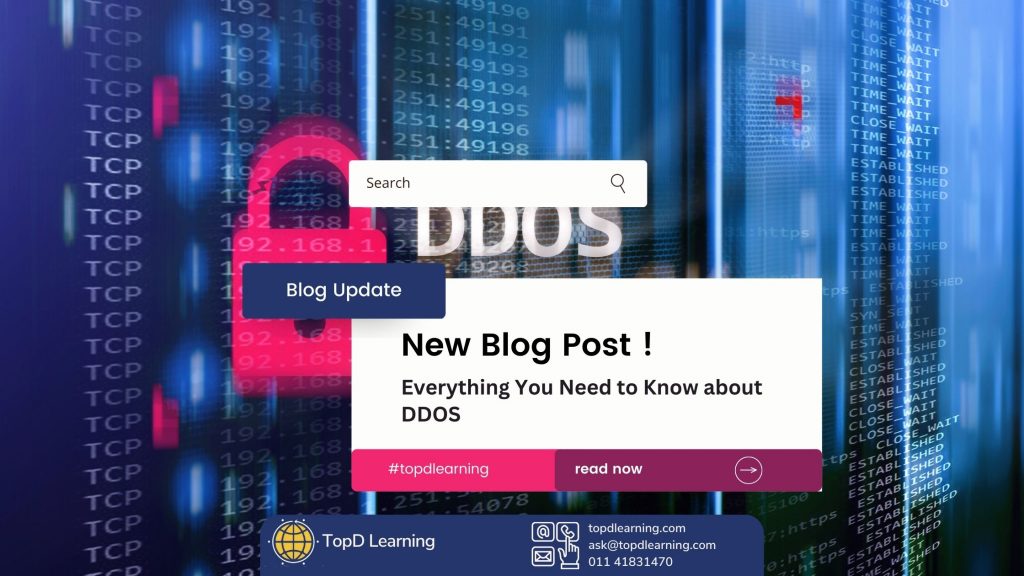Discover the fundamentals of DDoS attacks, their impact on businesses, and best practices for prevention and mitigation in our comprehensive guide.
Introduction
In an era of growing cyber threats, Distributed Denial of Service (DDoS) attacks have become an increasing concern for businesses around the world. These attacks can cause significant disruption, financial loss, and reputational damage, making it crucial for organizations to understand the intricacies of DDoS attacks and implement effective prevention and mitigation strategies. In this blog, we will delve into the world of DDoS attacks, exploring how they work, their impact on businesses, and the best practices to safeguard your organization’s digital assets.
Table of Content
- Introduction to DDoS Attacks
- How DDoS Attacks Work
- Impact of DDoS Attacks on Businesses
- Preventing and Mitigating DDoS Attacks
Main Content
Introduction to DDoS Attacks
Distributed Denial of Service (DDoS) attacks are a growing threat in the world of cybersecurity, targeting organizations of all sizes and industries. A DDoS attack is a malicious attempt to overwhelm a targeted system, such as a website or online service, by flooding it with an excessive amount of traffic from multiple sources. The goal of these attacks is to render the targeted system inaccessible to its intended users, causing disruptions, downtime, and potential loss of revenue.
Understanding DDoS attacks is crucial for businesses and individuals alike, as the consequences of a successful attack can be severe. In a world where online presence is increasingly vital for organizations, being able to identify and prevent DDoS attacks is essential to maintaining a secure and reliable digital environment. This not only helps protect your organization’s reputation, but it also safeguards your customers and users from the fallout of an attack.
By learning about the different types of DDoS attacks and how they work, you can better equip yourself and your organization to defend against this ever-evolving threat. In this blog post, we’ll explore the mechanics behind DDoS attacks, the potential impact they can have on businesses, and the best practices for preventing and mitigating their effects.
How DDoS Attacks Work
To effectively combat DDoS attacks, it’s important to understand the mechanics behind them. DDoS attacks can be categorized into three main types: volumetric, protocol, and application-layer attacks. Each type targets different aspects of a system and employs unique strategies to achieve its goal.
Volumetric Attacks:
Volumetric attacks are the most common form of DDoS attacks, focusing on overwhelming a target’s network bandwidth. In this type of attack, the malicious traffic is generated from multiple sources, often through the use of botnets, which are networks of compromised devices controlled by an attacker. The goal is to flood the target with so much traffic that legitimate users cannot access the service or website. Common volumetric attacks include UDP floods, ICMP floods, and DNS amplification attacks.
Protocol Attacks:
Protocol attacks target the communication protocols used by a target’s network, aiming to exploit weaknesses or vulnerabilities in these protocols. These attacks often focus on exhausting resources such as firewalls, load balancers, or servers by sending malformed or malicious packets that consume system resources. Examples of protocol attacks include SYN floods, Ping of Death, and Smurf attacks.
Application-Layer Attacks:
Application-layer attacks, also known as Layer 7 attacks, target specific applications or services running on a target system. These attacks are more sophisticated and stealthy, as they mimic legitimate user behavior, making them harder to detect. The goal is to exhaust the application’s resources or exploit vulnerabilities within the application itself. Examples of application-layer attacks include HTTP floods, Slowloris, and XML-RPC pingback attacks.
Attackers use various methods and tools to execute DDoS attacks. Some common methods include:
Botnets: As mentioned earlier, botnets are networks of compromised devices that an attacker can use to generate massive amounts of traffic. Botnets can be composed of various devices, including computers, smartphones, and Internet of Things (IoT) devices.
Reflection and Amplification: Attackers can exploit misconfigured servers or network devices to amplify the amount of traffic directed at the target. This technique increases the impact of an attack by generating more traffic than the attacker’s own resources would allow.
Malware and Exploits: In some cases, attackers may use malware or exploits to gain control of a target system, allowing them to directly launch a DDoS attack from the compromised system.
By understanding how DDoS attacks work and the different types of attacks, you can better prepare your organization to defend against these threats and minimize their impact on your digital infrastructure.
Impact of DDoS Attacks on Businesses
DDoS attacks can have severe consequences for businesses, ranging from financial losses to reputational damage. Understanding the potential impact of these attacks is crucial for organizations to take appropriate measures to protect their digital assets and ensure business continuity.
Potential Consequences of a Successful DDoS Attack are:
Downtime: A DDoS attack can render a website or service inaccessible, leading to downtime and loss of revenue. The longer the downtime, the more significant the financial impact on the business.
Loss of customer trust: Frequent or prolonged downtime due to DDoS attacks can erode customer trust and lead to a loss of clients, especially if sensitive data is compromised during an attack. Customers may choose to do business with competitors that they perceive to have better security measures in place.
Reputational damage: DDoS attacks can tarnish a company’s reputation, affecting its brand value and making it difficult to attract new customers or retain existing ones. News of a successful attack can spread quickly, especially on social media, resulting in lasting damage to the company’s image.
Legal and regulatory repercussions: Organizations that fail to protect their digital assets from DDoS attacks may face legal and regulatory penalties, particularly if they are found to be negligent in implementing adequate security measures. Depending on the jurisdiction, companies may be subject to fines, lawsuits, or other penalties for failing to prevent or mitigate the impact of a DDoS attack.
Increased operational costs: Recovering from a DDoS attack often involves significant operational costs, such as investing in more robust security measures, hiring external security experts, or paying for additional bandwidth to mitigate the effects of an attack. These costs can add up quickly, putting further strain on a company’s finances.
Loss of intellectual property: In some cases, DDoS attacks can be used as a smokescreen for more targeted cyberattacks that aim to steal sensitive data or intellectual property. Businesses that lose valuable information during an attack may find themselves at a competitive disadvantage or facing further financial losses as a result.
Employee morale and productivity: DDoS attacks can also have an impact on employee morale and productivity. The stress and disruption caused by an attack can lead to increased employee turnover, reduced job satisfaction, and lower overall productivity as staff members are forced to deal with the fallout from the attack.
Understanding the potential consequences of DDoS attacks is essential for businesses to take the necessary steps to protect themselves and minimize the impact of such attacks on their operations.
Preventing and Mitigating DDoS Attacks
Implementing robust prevention and mitigation strategies is crucial for businesses to safeguard their digital assets from DDoS attacks. By following best practices and leveraging the right tools and services, organizations can minimize the impact of these attacks and maintain their online presence.
Best Practices for DDoS Prevention and Mitigation:
Implementing a robust network infrastructure: Ensure that your network infrastructure is designed to handle sudden increases in traffic, with redundant systems in place to prevent single points of failure. This can help maintain service availability during a DDoS attack.
Monitoring network traffic: Regularly monitor and analyze network traffic to detect unusual patterns or spikes in activity that may indicate a DDoS attack. Early detection can enable a faster response, minimizing the impact of an attack.
Employing traffic filtering: Implement traffic filtering mechanisms, such as rate limiting or IP blocking, to filter out malicious traffic while allowing legitimate traffic to pass through.
Deploying web application firewalls (WAFs): WAFs can help protect your web applications from application-layer DDoS attacks by monitoring and blocking suspicious traffic based on predefined rules.
Regularly updating and patching systems: Keep all systems, software, and firmware up-to-date with the latest security patches to minimize potential vulnerabilities that attackers can exploit.
Creating an incident response plan: Develop a comprehensive incident response plan that outlines the steps to take in the event of a DDoS attack. This plan should include communication protocols, roles and responsibilities, and procedures for restoring services.
Tools and Services Available for DDoS Protection:
Several tools and services are available to help businesses prevent and mitigate DDoS attacks, including:
DDoS protection services: Specialized DDoS protection services, such as Cloudflare, Akamai, and Imperva, offer comprehensive solutions to protect your online presence from DDoS attacks. These services typically provide a range of features, including traffic filtering, rate limiting, and content delivery network (CDN) integration.
Content Delivery Networks (CDNs): CDNs help distribute your website’s content across multiple servers around the world, ensuring that your website remains accessible even during a DDoS attack. CDNs can also help mitigate DDoS attacks by absorbing and distributing the malicious traffic.
Intrusion Detection Systems (IDS) and Intrusion Prevention Systems (IPS): IDS and IPS solutions can monitor network traffic for signs of potential DDoS attacks and take action to block or mitigate the attack in real-time.
On-premises DDoS protection appliances: Some businesses may choose to deploy on-premises DDoS protection appliances to help detect and mitigate DDoS attacks at the network perimeter.
By combining best practices with the right tools and services, businesses can effectively prevent and mitigate DDoS attacks, ensuring the continued availability of their online services and minimizing the potential impact on their operations.
Conclusion
In today’s interconnected digital landscape, DDoS attacks pose a significant threat to businesses of all sizes. Understanding the intricacies of these attacks, their potential impact, and the best practices for prevention and mitigation is essential for organizations looking to safeguard their online presence.
At TopD Learning, we recognize the importance of cyber security and offer Cyber Security training courses to help businesses stay ahead of evolving threats. By investing in cyber security training, businesses can equip themselves with the knowledge and skills necessary to protect their digital assets and maintain a resilient online presence in the face of DDoS attacks. Contact us to learn more.
Frequently Asked Questions, Answered
- What is the main purpose of a DDoS attack?
The primary goal of a DDoS attack is to overwhelm a target system or network with a massive amount of traffic, rendering it unavailable to legitimate users. These attacks can cause significant financial and reputational damage to businesses.
- Can small businesses be targeted by DDoS attacks?
Yes, small businesses can also be targeted by DDoS attacks. In fact, they may be more vulnerable as they often lack the resources and expertise to implement robust cyber security measures. It is essential for small businesses to prioritize their cyber security to minimize the risk of DDoS attacks and their potential impact.
- How long do DDoS attacks typically last?
The duration of a DDoS attack can vary widely, ranging from a few minutes to several days or even weeks. The length of an attack depends on factors such as the attacker’s motivation, the target’s cyber security measures, and the effectiveness of the mitigation strategies in place.
- What are some common signs of a DDoS attack?
Some common signs of a DDoS attack include a sudden slowdown or unavailability of a website, an unusually high volume of traffic, and unexplained spikes in bandwidth usage. Monitoring network traffic and system performance can help businesses identify and respond to DDoS attacks more effectively.


